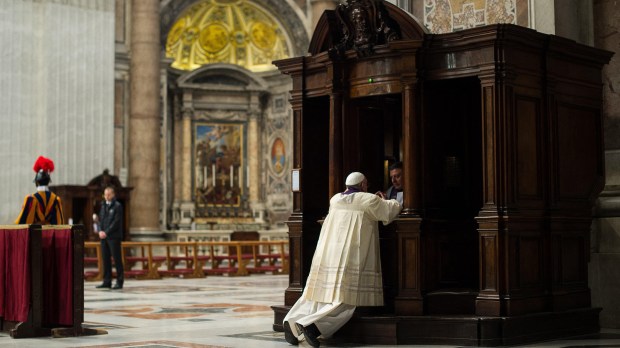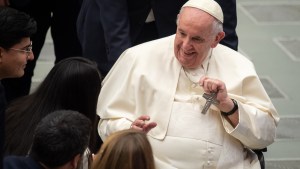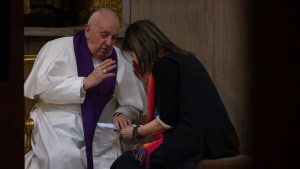On Friday, March 8, Pope Francis presided over a penitential celebration at the parish of St. Pius V, west of Rome. During the ceremony he heard the confessions of several of the faithful. At the start of his pontificate, the Argentinian pope surprised the public by going to confession himself at this annual Lenten celebration.
He probably did this because it was precisely this sacrament that inspired his vocation. “In fact, on the Feast of St. Matthew in 1953, the young Jorge Bergoglio experienced, at the age of 17, in a very special way, the loving presence of God in his life. Following confession, he felt his heart touched and he sensed the descent of the Mercy of God, who with a gaze of tender love, called him to religious life, following the example of St. Ignatius of Loyola,” says the Vatican website.
And indeed, Pope Francis has often spoken openly about this turning point in his life. It took place on September 21, 1953, St. Matthew the Evangelist’s feast day, which was also “Students’ Day” in Argentina.
“I was getting ready to go on a picnic with my classmates. I passed the church of San José de Flores and went inside (…) and, there, I felt an impulse to go to confession. I don’t know what happened, or how long the confession lasted. But I stood up, went home, and gradually realized that God was calling me,” he recounts in Des pauvres au Pape, du Pape au monde (“From the Poor to the Pope, From the Pope to the World”), published by Seuil in April 2022.
Bergoglio’s tears
The young Jorge Mario Bergoglio didn’t know this priest, who, astonishingly, was a former theater actor. Hailing from the province of Corrientes, he was staying in the Argentine capital to undergo leukemia treatment. His service as confessor at the church of San José, located on the immense Rivadavia avenue — which stretches for 22 miles and crosses the whole of Buenos Aires — was therefore purely occasional and fortuitous.
“Ten months after we met, he died. He was the one who guided me, the one who helped me. Indeed, I continued to see him,” recalls Pope Francis. “After his funeral, I went home and cried and cried. I was in a state of anguish, feeling abandoned. I’ll always remember those tears. After that, things went slowly. But the certainty came that day on September 21, 1953. The certainty of a gift,” says Pope Francis in the same book, with disarming sincerity.
The young Jorge Mario Bergoglio nevertheless continued his studies in chemistry until he entered the diocesan seminary in 1956. He then suffered serious health problems, after which he joined the Jesuits.
Because of the very long period of formation within the Society of Jesus, Jorge Mario Bergoglio was not ordained a priest until 1969, almost 16 years after his call, and not without having gone through some periods of doubt. He admits to having doubted his vocation after being moved by the “beauty and intellectual brilliance” of a young woman he met at a wedding while he was a seminarian. In the end, however, he would remain anchored to the memory of this confession, which marked the end of his adolescence.
A moment both ordinary and extraordinary
Since the beginning of his pontificate, he has liked referring to this moment, both ordinary and extraordinary, to invite all priests and consecrated men and women to remember the moment of their “first call” that gave meaning and consistency to their vocation. The priestly or religious life cannot be the result of a “career plan” or an ambition planned by others, he never ceases to hammer home, but is first and foremost the result of a personal encounter with the Lord.
This memory is also at the root of his episcopal motto, Miserando atque eligendo. This Latin phrase refers to the Gospel episode of St. Matthew’s vocation, depicted in the famous painting by Caravaggio that the future Pope Francis loved to contemplate in the Church of St. Louis of the French when he was in Rome as a cardinal.
The full quotation is found in a Latin homily by St. Bede the Venerable, Doctor of the Church, who died in 735: Vidit ergo Iesus publicanum et quia miserando atque eligendo vidit, ait illi Sequere me – “Jesus saw a publican, and because as he looked at him he had mercy on him and chose him, he said to him, ‘Follow me.'”
The three Latin words miserando atque eligendo are rich in interpretation, and can also be translated as “he chooses him by ‘mercying’ him,” i.e., “by enveloping him in his mercy.” This image is similar to that of the priest as mediator of God’s mercy, and as a simple “forgiven sinner.”
This manifestation of God’s love can happen at any moment of life, even the most unexpected. Pope Francis’ vocation and magisterium thus derive from the simple confession of an Argentinian teenager out for a walk with his friends, over 70 years ago. An experience of God’s mercy that he has been eager to share ever since.



